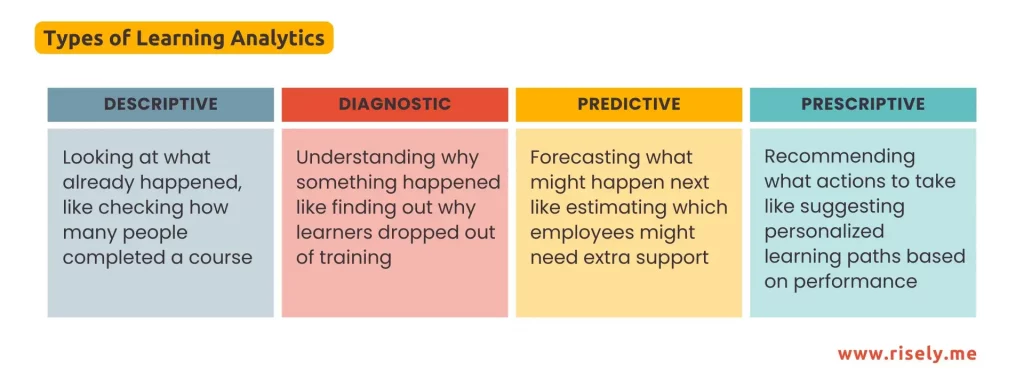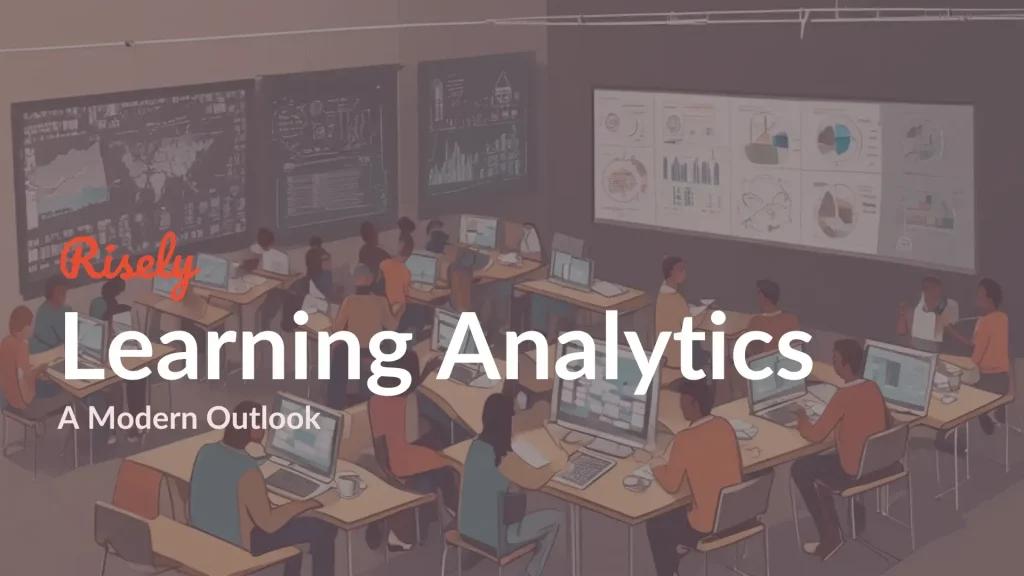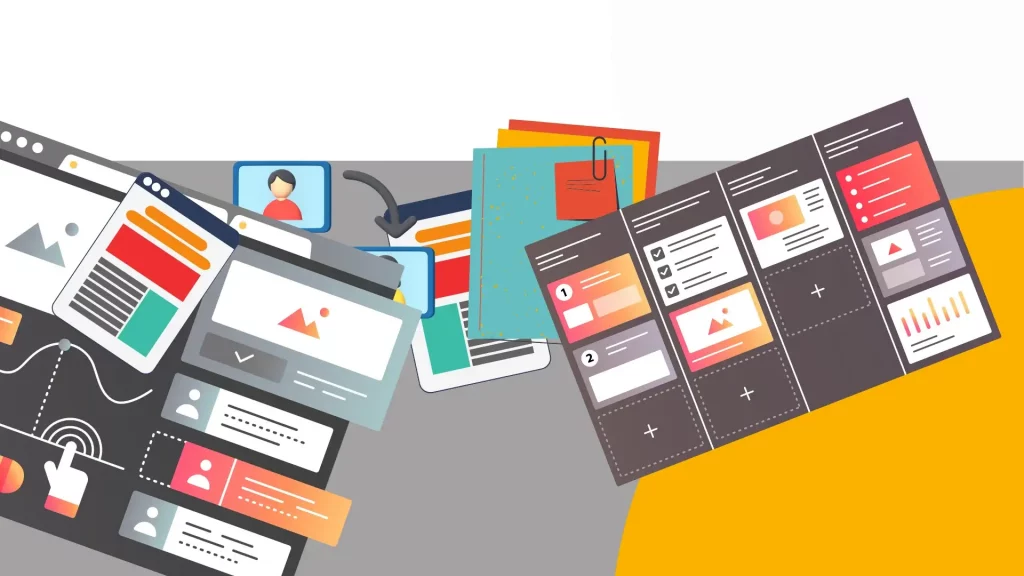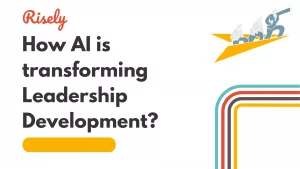Learning Analytics – A Modern Outlook
Learning analytics is changing the way we look at research. It uses data to help improve learner success. With the insights from this data, L&D teams better understand how employees learn. This helps them learn more about employees behavior, likes, and performance. As a result, you can create better learning and development strategies. It allows for personalized learning experiences and timely help for your employees and successful interventions focused on business goals.What is learning analytics?
This field combines research, data science, and analytics to find useful information from the large amounts of data produced in workplaces to create impactful learning programs.Learning analytics refers to the process of collecting and analyzing data about how people learn to improve training effectiveness. It focuses on the measurement, collection, analysis, and reporting of data about learners and their educational set-ups.
By looking at patterns, trends, and connections in this data, L&D professionals make better choices. You can adjust your teaching methods and create a learning environment that encourages learner engagement, success, and well-being.What data should we be collecting?
Learning analytics is not simply data about who is learning what. Instead, it allows you to take a more data-driven approach to solve your organization’s learning challenges and enhance outcomes. For example, if an employee struggles with a particular task or concept, the system can suggest relevant resources or training modules to promptly address the issue. This targeted approach enhances individual performance and aligns with broader business goals by ensuring that employees have the necessary skills to contribute effectively to the organization. Some other examples of learning analytics at work include:- Tracking the performance of a sales team pre and post-training implementation
- Monitoring the engagement of a team on the learning platform
- Using skill assessments to find out role-based skill and competency gaps
- Identifying the costs involved in training per employee and its resultant impact on performance
- Measuring the effectiveness of content in terms of engagement rates and feedback
How do learning analytics help you?
Learning analytics are an L&D team’s go-to tool for getting answers in many critical business areas. But before jumping on to that, let’s look through the ways learning and development teams can use learning analytics in different aspects:
- Ensure training effectiveness: Learning analytics are the first and foremost way to track the effectiveness of your training and development plans. You can consider filling skill gaps, rectifying performance issues, or determining how employees work with the learning content. It can further help you evaluate and make smart choices when it comes to planning, structuring, and designing learning and development strategies for your organization.
- Calculating ROI: Many training programs have an ROI that is difficult to quantify or often ignored. Learning analytics prevents this and ensures that you can consistently evaluate and showcase the results of your efforts. It further helps in resource and budget allocations and creates proof of L&D success for relevant stakeholders.
- Create better workforce planning practices: Learning analytics, specifically with workforce planning, such as upskilling and succession planning, can help your overall HR strategy be more effective and fail-proof. It includes preparing for future skill needs and adapting to industry trends to retain a competitive edge.
- Learn how employees want to grow: Learning analytics gives you a bird’ s-eye view of what your employees want in terms of learning opportunities, how they are using the existing ones, and what you can do to create more in the future. As a result, you can emphasize learner-centricity with data-driven insights. It further ties into career development and growth plans for employees.
- Keep building good content: As L&D professionals, we simply do not want to create content. We want to create learning content that efficiently resonates with employees and solves their problems. Learning analytics support this principle by tracking how employees engage with content, their satisfaction levels, retention, and application.
- Compliance and risk management: These are essential concerns for many training and development programs because our environment is constantly evolving. Analytics help you see whether you are able to keep up or whether there’s a gap between the training that employees need and what you are currently offering. Moreover, it helps you comply with legal and normal training requirements.
- Decode the business impact of L&D: That’s the most vital function of learning analytics because, ultimately, it is a question of impact. As little as about 5% of companies evaluate their training programs. Evaluation and analysis can put you among the top innovators and builders in the L&D space and ensure that the organization recognizes your contributions.
Key business questions learning analytics can answer across various L&D focus areas:
| Training Effectiveness | How well are employees retaining information? Which learning methods are most effective for different roles? Are employees applying what they’ve learned on the job? Which courses have the highest/lowest success rates? How does training impact employee performance metrics? |
| Return on Investment (ROI) | What is the cost per learner for each program? How does training investment correlate with performance improvement? Which programs deliver the best value for money? What is the opportunity cost of training time? How does e-learning ROI compare to instructor-led training? |
| Skill Gaps and Workforce Planning | Where are the current skill gaps in the organization? Which departments need additional training? How prepared is the workforce for future skill requirements? What competencies are most critical for specific roles? How effective is the current upskilling strategy? |
| Employee Engagement and Behavior | When and how do employees prefer to learn? What motivates employees to complete training? Which content formats drive the most engagement? How do social learning features impact participation? What barriers prevent training completion? |
| Content Optimization | Which learning materials are most/least effective? What content needs updating or removal? How can we improve course design? Where do learners struggle or drop off? What additional resources do learners need? |
| Compliance and Risk Management | Are employees up-to-date with required training? How quickly are compliance gaps addressed? What is the certification completion rate? Which areas pose the highest compliance risk? How effective is mandatory training? |
| Career Development and Succession Planning | Who are the high-potential learners? What learning paths lead to successful role transitions? How effective are leadership development programs? Which skills correlate with career advancement? How well are we preparing future leaders? |
| Business Impact | How does training affect key performance indicators (KPIs)? What is the impact on customer satisfaction? How does learning contribute to employee retention? What is the relationship between training and productivity? How does learning affect innovation and adaptability? |
What are the common methods of learning analytics?
Primarily, learning analytics can be of four types. Let’s understand each of these in detail below:
#1 Descriptive analytics – What happened?
As the name suggests, descriptive analytics are all about things that have happened. They summarize the data collected historically over incidents and events to figure out trends and patterns. It will help you understand how the team received a certain training program, engaged with the material, and how many of them eventually completed the assignment. Some examples of descriptive analytics in L&D include course completion rates, time spent on modules, assessment scores, video watch times, login frequency, etc. With this, you can understand the performance of your present L&D functions. However, it cannot help you think of the next steps or predict employees’ future behavior.#2 Diagnostic analytics – Why did it happen?
Once we are aware of the what, the next question is why. Diagnostic analytics answers that question for L&D teams. It helps you understand the reasons behind your employees’ current learning behavior. It will help you answer questions like why some employees are not completing a training module or why around 75% of test takers fail at one specific point. A few examples of using diagnostic analytics in L&D include identifying common wrong answers in assessments, learning path bottlenecks, and performance gap analysis. Similar to descriptive analytics, diagnostic analytical methods also help you evaluate past and present behavior only.#3 Predictive analytics – What will happen?
This is an important question because who would not like to know the future? Predictive analytics, focused on identifying signs and possible future courses of action, helps L&D teams figure out how learning will be impacted by both internal and external factors. It can help you determine the skill and learning gaps that are about to be created as the industry moves forward, as well as the expected completion timelines and forecast future learning needs. Since L&D teams cannot afford to play catch up, predictive analytics are critical for L&D teams to keep up with the changing world.#4 Prescriptive analytics – What should you do?
Knowledge is one thing; the actions based on it are the real deal. That’s what prescriptive analytics help you determine. Prescriptive analytics are key to understanding the insights about the future course of L&D and putting them down into actionable steps. For instance, if you foresee the need for digital literacy in your sales team, prescriptive analytics will help identify what type of training you can do, what your employees are expecting, and how to conduct it efficiently, keeping the organization’s goals in mind. Similarly, a few other examples of prescriptive analytics include personalized learning recommendations and adaptive learning paths, intervention triggers, resource allocation suggestions, and content optimization recommendations.How to get started with learning analytics for your employees?
Setting up learning analytics for your team has many advantages. But it looks like a confusing task, doesn’t it? We can simplify this process and break it down into eight steps as follows:
#1 Create the foundation setup
Learning analytics is a tool for offering more clarity within and about the L&D strategy. Thus, clarity is what we should start with. The process begins by identifying the goals you want to achieve and the relevant KPIs for them. For example: If your goal is to improve sales team’s performance. Your KPIs will include:- Training completion rates for product knowledge courses
- Post-training assessment scores
- Time to reach sales quotas for new hires
- Number of successful sales demonstrations
- Customer satisfaction scores
- Internal benchmarking: Deriving a standard of scores based on the overall performance within the organization.
- External benchmarking: Deriving a standard based on the wider trends across the industry in similar organizations/competitors.
#2 Build the technical infrastructure for learning analytics
Learning analytics do not look the same for every organization. Instead, your team’s learning maturity, the level of comfort with digital infrastructure, and what you set out to solve impact the shape of the technical infrastructure you will use for analytics. It includes choosing appropriate tools that you might need, such as:- Learning Management System (LMS): An LMS is software that essentially manages learning content, delivery, and distribution for your team. It can have basic features like tracking logins and completion rates and collecting feedback through quizzes.
- Learning Experience Platform (LXP): An LXP is an evolved form of learning software that emphasizes keeping the individual user at the center with tailored recommendations and learning pathways. It can often have features to support social learning and microlearning, so you can also track those.
- Analytics dashboards: These visual interfaces display key learning metrics and data in real-time, such as Risely’s skill center for admins, which shows your learners’ progress on key people management skills. Some platforms offer a great deal of customization and automated reporting, too.
- Data visualization tools: These are simply tools that translate your data into clear visual representations. With tools like PowerBI and Tableau, you can create custom interfaces to match your needs, but managing these could be challenging.
- Survey and feedback platforms: Lastly, these are simply tools for collecting learner data and input to support your decisions. Many options exist, such as SurveyMonkey, Qualtrics, and Google Forms, which you can use for free or at a minimal charge.
#3 Create a data collection strategy
Once your goals and tools are set, you need to decide how you are going to collect the data. A few learning analytics tools we listed above support data collection. You can also look into performance reviews, collect feedback directly, and use methods like our skill gap analysis template and training evaluation forms. Given that we understand the impact of learning analytics across three areas, we will have three types of data to collect:- Learning data: It includes metrics such as training completion rates and time spent learning, along with metrics tracking learning application and transfer. Tracking resource usage and learning patterns is the key here.
- Performance data: Learning needs to impact performance ultimately, and these metrics show exactly that. It includes job performance metrics, skills assessments, certification progress, on-the-job application, and manager feedback.
- Business data: The last set of metrics tracks the impact of learning investment on business outcomes. It would include productivity metrics, customer satisfaction, employee retention, error rates, etc.
#4 Implement learning analytics
When you start implementing learning analytics at work, start with a smaller set of goals and metrics in your mind. You can pick something like the example used above. Start small with a few key metrics and learning programs targeted to a team or department. You will start with descriptive and diagnostic analytics, primarily to understand what is happening in learning and work and why it is happening. Once these are mastered, you can grow further in predictive and prescriptive capabilities and have a future-oriented outlook toward learning. Over time, you can test and refine the process and implement it. At the same time, ensure that you document learnings and mistakes as they happen. Over time, you should add more complex metrics and develop more sophisticated reports for the learning and development processes.#5 Enhance L&D team capabilities
To master learning analytics, you need a few team members trained to use learning analytics tools and interpret the results. It presents an opportunity to upskill the L&D function while running a test on how analytics for learning work. Further, once your capabilities grow, you can think of dividing the work across functions such as:- Data collection: The main responsibility includes gathering and organizing learning data systematically. This role requires comprehensive knowledge of data collection and processing and care toward ethical and normative guidelines.
- Analysis: An analyst is essentially a translator who converts raw data into meaningful points to consider and act upon. The skills needed here include statistical analysis, analytical thinking, data modeling, and problem-solving.
- Reporting: This is where your team creates clear, actionable reports from analysis. You need data visualization and automation skills here, as well as the ability to design and manage learning dashboards effectively.
- Stakeholder communication: All your audiences won’t understand what a training completion rate stands for. That’s why managing stakeholder communication is essential. It involves translating data insights for different audiences and needs skills such as communication, storytelling, and relationship management.
#6 Design a reporting framework
Once your data is collected, the rest hinges on effectively communicating them. This is why we need a reporting framework for learning analytics. A reporting framework will help you generate standardized reports across the organization and design intuitive dashboards. You can also set up automated reporting. The other focus area here is to create different views for different stakeholders that your L&D teams need to manage. For instance, the C-suite and executive leadership would appreciate focusing on business goals. Lower turnover and a positive employer brand can pique their interest. However, the stakes are different for a team manager who is implementing learning with their team. They would be more concerned about reducing skill gaps and properly using the learning opportunities to promote employee satisfaction. Similarly, the employees would be more concerned about how learning can enable them to achieve their long-term career goals. Thus, the same data needs to tell multiple stories. Read more: How to Obtain Buy-In for Training from Stakeholders?#7 Think of quality assurance
Quality is critical in any data-heavy process, and the same holds for learning analytics. Validating and cleaning the data is important to get helpful results. However, more concerns are hidden behind the curtains, such as error-checking protocols and legal bindings on how to use the data. Ensuring all of these things run properly means that you put a regular and comprehensive data audit process in place for the L&D team.#8 Continuously improve
Ultimately, there’s always more to learn. Learning analytics has the same journey. As you keep going, you can identify mistakes and determine the scope for improvement. For instance, you might discover that there are better metrics to track phenomena or there’s a better visualization platform that your team can use. Some considerations for improvement can include:- Is there a new tool for reporting/visualization/data collection that we can use?
- Are we tracking the right metrics?
- Does our team have the required skill set?
- Is our process efficient? Can we cut down on some excesses?
- Are we following the privacy compliance directives properly?
- Is our data accurately collected and reported?
Wrapping up
Learning Analytics is changing learning at work for the better. It gives useful insights that help to create personalized learning experiences and improve results for employees. When L&D teams use data correctly, they can increase learner engagement and spot where help is needed. As technology improves, AI’s role in learning is getting bigger. This is leading to better predictive analytics and smarter decision-making. Still, there are challenges like privacy concerns and skill gaps that need attention. Looking to the future, learning analytics shows exciting trends and changes that will influence new workplace learning strategies.Deeksha, with a solid educational background in human resources, bridges the gap between your goals and you with valuable insights and strategies within leadership development. Her unique perspectives, powered by voracious reading, lead to thoughtful pieces that tie conventional know-how and innovative approaches together to enable success for management professionals.
Get Started with the Free Training and Development Plan Template!
Grab free L&D resources and more for holistic growth of people managers.
Only on Risely.







